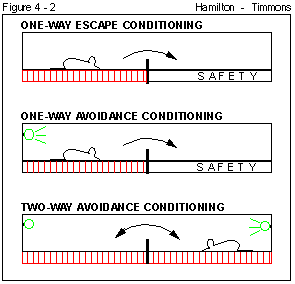
The shuttle box is one of the standard pieces of apparatus for studying learned responses to
aversive stimuli:
- One-way escape conditioning is very simple, requiring only that the subject move to the other end of the chamber to escape the ongoing electric shock.
- One-way avoidance conditioning adds an explicit warning signal (CS) that shock will begin shortly, providing an opportunity to move to the safety zone and avoid the electric shock altogether.
- Two-way avoidance provides a CS at either end to allow the avoidance of electric shock, but the conflict of returning to a place that is not always safe sets up conflict and makes the task difficult to learn.






